Ferry crossing
-
I know this has already been discussed here a few times - but I'm interested to know if there is now a solution.
I can't get a specific ferry connection to be used for a route. I have enabled disable seasonal clusures and set route optimisation to shortest. But it doesn't work:https://www.myrouteapp.com/en/social/route/9966502?mode=share
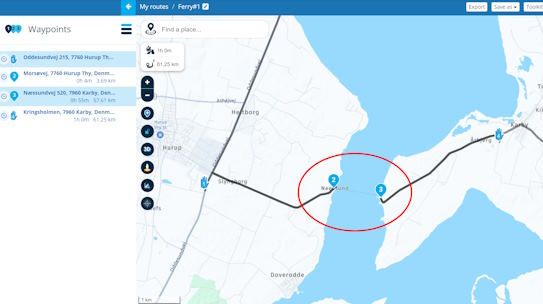
Other route planners (e.g. Google) use the ferry connection without any problems. Of course I can ‘skip’ the route between points 2 and 3, but this no longer works when navigating.
I know that this is not a problem with MRA but with HERE - but is there any trick to enable the ferry connection?
-
@Martin-Wilcke Set the
travel profiletransport mode to "car" in your route. In the web planner, select Route Optimization > shortest route in the Toolkit menu. This workaround is not possible within the motorcycle profile because the map provider has not built that in. -
@Rob-Verhoeff
Is "travel profile" the same as "transport mode"?
It is set to "car".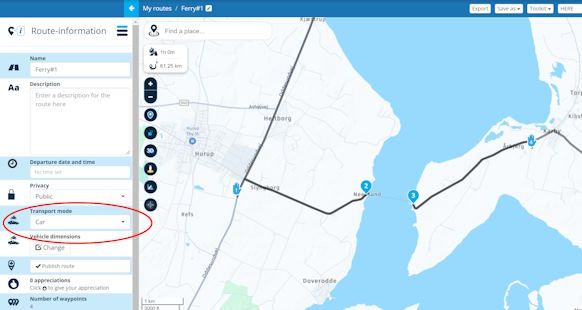
-
@Martin-Wilcke Sorry, yes.
-
@Rob-Verhoeff
OK - I've set everything the recommended way, but it still doesn't work. Do you have any more tips? -
@Martin-Wilcke set route optimalisation to shortest
-
@Martin-Wilcke My preference is to use the skip function and not adjust transport mode or route optimisation. Choosing shortest route can affect other parts of the route, for instance, using unnecessary shortcuts on smaller roads.
The skip function only adjusts the route in the route planner but depending on which navigation device you use the ferry crossing may be included and used in your navigation device. The planning maps from TomTom and OpenStreetMap both use the ferry crossing, so if you use a TomTom you would not encounter a problem.
I’m guessing that you use either a Garmin based device or MRA Navigation Next as your route is created on the HERE planning map, so here is what I would do:
As I have already mentioned, I would select the skip function for your route point 3, I would also make RPs 2 and 3 via points. I would change the colour of RP2 and add the ferry icon, this makes the RP stand out (in MRA Navigation Next) and the via point means that you must visit it. I would also give the title Ferry and add a short note (maybe the cost of the ferry) to RP2. MRA Navigation Next and some Garmins can display or read aloud the titles and notes written in route points.
So in reality, if your device does not recognise the ferry crossing, the via point will take you to the ferry and even though it may then tell you to turn around, you know that the ferry crossing is part of your journey. When you get to the other side, navigation will resume as normal and you can continue your journey without changing motorcycle mode or the fastest route.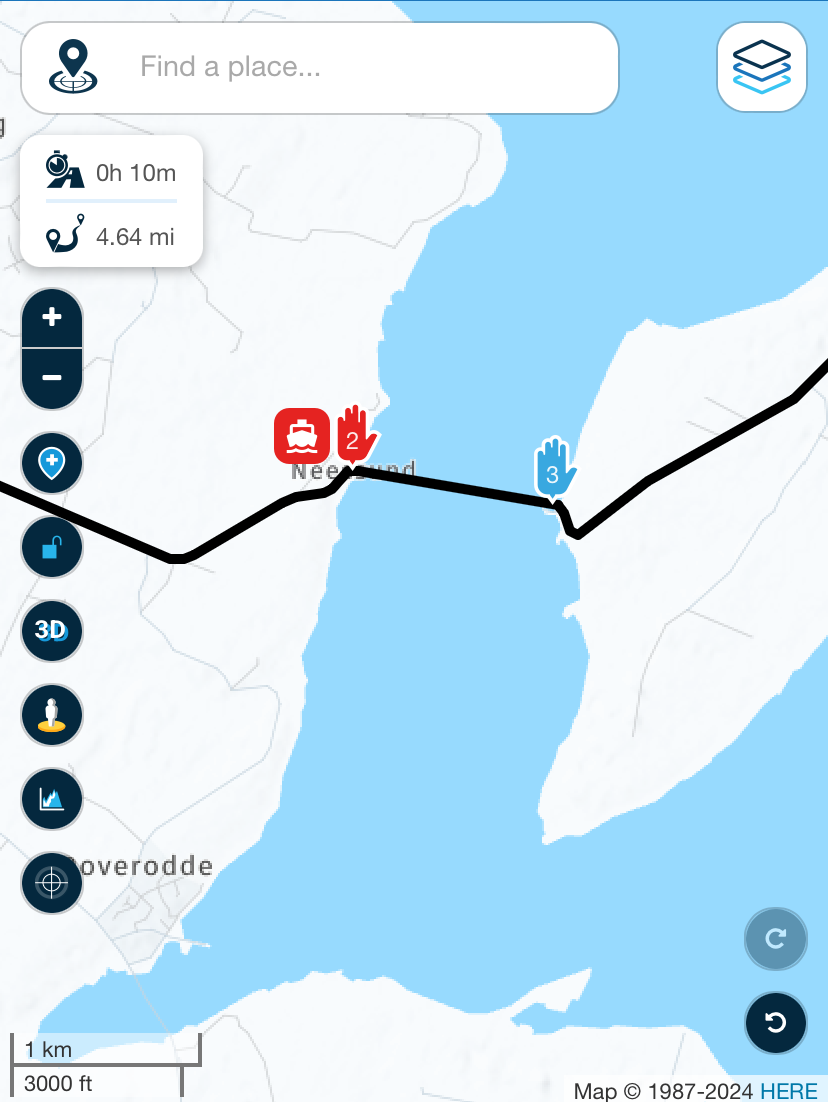
-
@Martin-Wilcke Normally, the route with the options I suggested should take the ferry. This option is also my preference because the map provider adds little to nothing with the motorbike profile. In this case, that doesn't work, and I don't understand why. Therefore, in your case, Nick's option is the recommended method.
-
@Rob-Verhoeff said in Ferry crossing:
@Martin-Wilcke Normally, the route with the options I suggested should take the ferry. This option is also my preference because the map provider adds little to nothing with the motorbike profile. In this case, that doesn't work, and I don't understand why. Therefore, in your case, Nick's option is the recommended method.
Auch wenn es schwer zu verstehen ist, der Anteil an Motorradfahrer mit größerem „Gerät“ im Verkehr ist in D nur 10%. In südlichen Länder gibt es tw. mehr Zweiräder, aber dann vielfach Roller für den Stadt- und Nahverkehr und nicht als Reisefahrzeuge.
Die Prioritäten von Here sind halt nicht bei den Bikern und wie bekannt ist deren Entwicklungsschwerpunkt aktuell das Unterstützen des autonomen Fahrens.Ein jeder der hier sein Problem sieht, was nicht supportet wird,muss sich selbst fragen, womit verdiene ich eigentlich mein Geld und würde ich was tun, wo zu wenig zu verdienen ist.
In einem solchen Fall ist man bei OSM, aber nicht bei HERE. -
@Marinus-van-Deudekom said in Ferry crossing:
set route optimalisation to shortest
I did so. Please see post #1.
-
Thanks, @Nick-Carthew .
I used Garmins for about two decades and was happy. However, I never looked back after switching to "Smartphone navigation" two years ago. There are a lot of exciting apps out there, but MRA Navigation Next is by far the best all-in-one solution, and that's my choice.
Your suggestions are the best option. The only downside is that the routes' calculated time and distance are too long. So, adding a note to the description might be worth it.
The second best option would be to break it up into two routes - hmmm.
The third option is to take it as a sign of fate and not use the ferry

-
-
@Martin-Wilcke said in Ferry crossing:
The second best option would be to break it up into two routes - hmmm.
Simply ignore the directions and navigate to the ferry by placing a viapoint there (handsymbol). Once you're on the other side, you'll see that MRA will automatically pick up the route again. So, you just need to look past the suggested route until you reach the ferry. On the other side, all will be resolved

-
@Martin-Wilcke Using the skip function does not include time and distance, the time and distance is calculated as zero. Without using the skip function the time of the route is 1 hour instead of 10 minutes + ferry time.
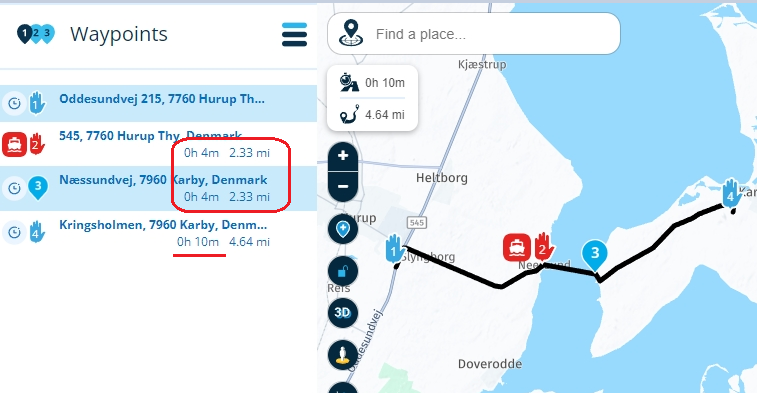
-
@Nick-Carthew said in Ferry crossing:
Using the skip function does not include time and distance, the time and distance is calculated as zero
That's true when planning. However, the effect may appear when opening the route in MRA NN:

A simple note might help avoid confusion. That's what I meant.
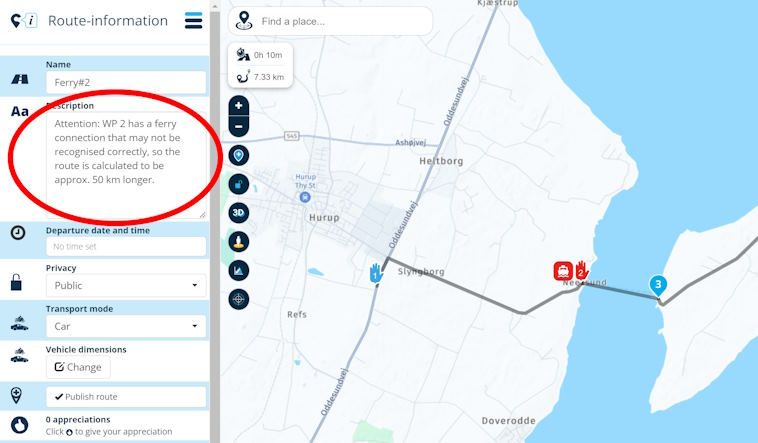
-
@Martin-Wilcke A good point well made

-
HERE should just skip all ferry time schedules for inland ferries, and add a 10 minute duration time or even set it to zero. For preventing navigation over ferries there already are features available.